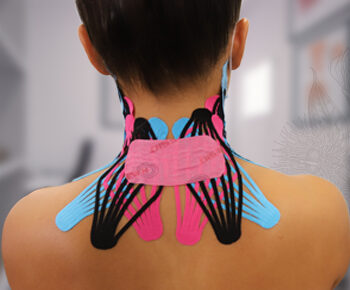Kinesiotaping

Kinesiotaping is a technique that involves the application of a specialized elastic tape to the skin to treat pain and other musculoskeletal conditions.
The tape used in kinesiotaping is made of a stretchy, cotton-based material that is designed to mimic the properties of human skin.
Why kinesiotaping ?
The goal of kinesiotaping is to provide support and stability to the muscles and joints without restricting movement or compromising circulation. The tape is applied in specific patterns and tensions to target different areas of the body and achieve different treatment goals. The tape is commonly used by physiotherapists to:
- relieve your pain
- improve joint stability
- enhance athlete confidence
- reduce injury recurrence
- prevent injury
- reduce strain on injured or vulnerable tissues
- correct faulty biomechanics
- inhibit muscle action
- facilitate muscle action
- enhance proprioception
- compress in the presence of edema or lymphatic drainage
CONDITIONS IN WHICH TAPING WILL HELP
- ACL injury
- low back ache
- cervical spondylosis
- Scoliosis
- Primary lateral patellar dislocation
- De Quervain’s syndrome
- Carpal tunnel syndrome
- Wrist pain
- Pregnancy-related low Back pain
- Mechanical neck pain
- Upper trapezius pain (myofascial trigger points)
- poor posture
Knee osteoarthritis (OA)
Benefits of kinesiotaping
Some of the potential benefits of kinesiotaping include:
- Pain relief: Kinesiotaping may help to reduce pain and discomfort associated with a variety of musculoskeletal conditions, including back pain, shoulder pain, and knee pain.
- Improved circulation: The stretchy nature of the tape can help to improve blood flow and lymphatic drainage to the affected area.
- Enhanced proprioception: Kinesiotaping can help to improve proprioception, which is the body’s ability to sense its position and movement in space. This can help to improve balance and reduce the risk of injury.
- Increased range of motion: Kinesiotaping can help to improve flexibility and range of motion in the affected muscles and joints.
Principles of taping
- Protection of the skin-Check the skin sensitivity of the person to be taped that he is not allergic to the adhesive tape. Make sure there are no existing rash or broken skin in the area to b taped.
- Hair removal in the area to be taped-It is better if the hair is removed 12 hours prior to the tape application to reduce skin irritation.
- Clean and prepare the skin
- The padding of the sensitive areas with adhesive tape
Properties
Kinesio Tex Tape contains either 100% cotton and elastic fibres or a blend of polyester and cotton with elastic fibres. The latter is preferable for Kinesio Taping application on sensitive skin when higher tensions on the tape are needed for the desired outcome.
Other characteristics of Kinesio Tex Tape include…..
- Ability to stretch to 120-140% of its original length
- Recoil back to the anchor that is applied without stretch
- Heat-activated adhesive
- Hypoallergenic dyes that make the tape safe for most users
- Latex-free
- Drying time after being wet is about 5-10 minutes
- Can be worn for several days
precautions
- Diabetes
- Congestive heart failure (CHF)
- Patient receiving dialysis/Kidney disease
- Organ transplants
- Pregnancy
